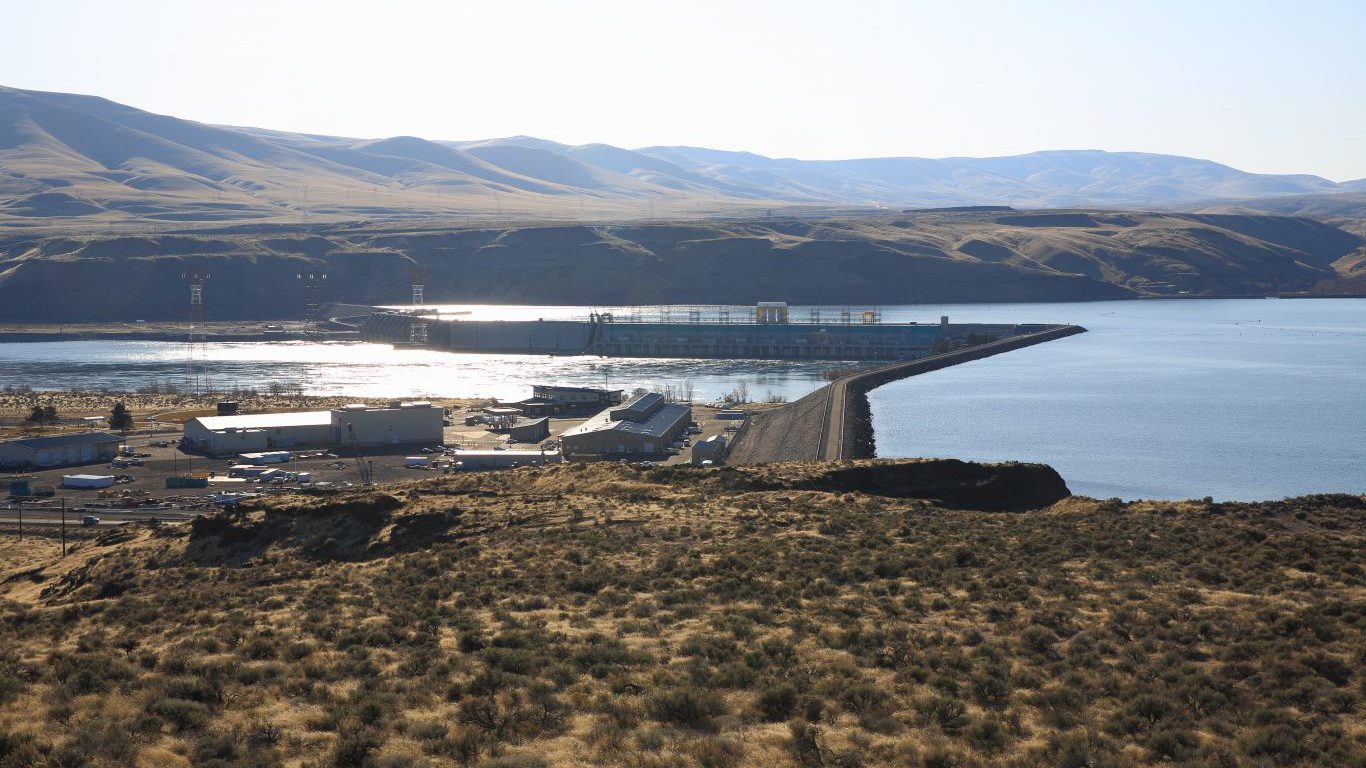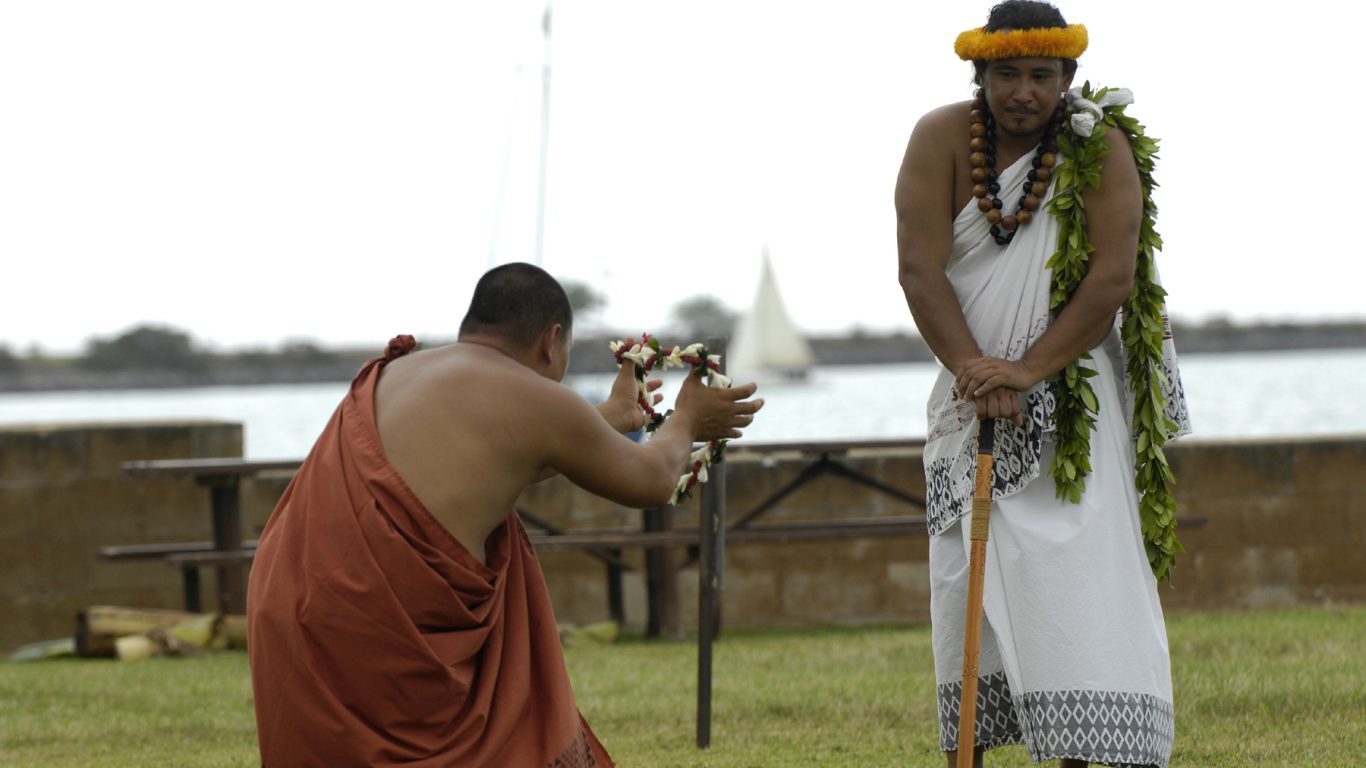Special Report
States With the Most Indian Reservations and Tribal Areas

Published:
Last Updated:

Most of us were taught as young children that the first Thanksgiving was a shared autumn harvest feast between Wampanoag Indians and early colonists in 1621. Often, however, the suffering of the Indigenous population shortly after the feast, and for the several centuries since, is brushed aside.
Today, Native American culture is concentrated in many of the nation’s tribal areas, including reservations, tribal statistical areas, home lands, and off-reservation trust lands. Not all federally recognized reservations are called reservations, though. Various states in the Western U.S. refer to such land areas as pueblos, rancherias, missions, villages, and communities.
While there are currently 326 federally recognized Indian reservations, there are nearly 700 tribal areas. For this reason, we didn’t limit our review to just reservations, but rather found the states with the most tribal areas.
For example, there is not one single federally recognized reservation in Hawaii, yet there are 75 tribal areas consisting of Native Hawaiians. In Alaska, there is only one federally recognized reservation, but the state has over 200 tribal areas, most of which are categorized as Alaska native village statistical areas (ANVSAs).
24/7 Wall St. reviewed the 2017 American Census Bureau to identify the states with the largest American Indian Reservations. We selected the five states with the most Indian reservations and tribal areas. In some cases, reservations go across state borders. This is the case with California, where there are 103 Indian reservations and tribal areas within state borders and four that are partially in the state. We considered these four in the total count of reservations in California.

5. Washington
> No. of tribal areas: 29
> Total pop. of tribal areas in state: 167,669
> Largest reservation: Puyallup Reservation and Off-Reservation Trust Land
Washington state is home to 29 tribal areas. Interestingly, there are just as many federally recognized tribes in the state as there are tribal areas. The largest tribal area in Washington is the Puyallup Reservation and Off-Reservation Trust Land, where over 167,000 American Indians currently reside. The second largest federally recognized reservation is Yakama Nation Reservation and Off-Reservation Trust Land, home to over 31,466 people.
In Washington, just over 3% of the population self-identifies as Native American or claims to have Native American heritage. That’s the 10th highest concentration of Native people of any state. With a higher prevalence of Native culture in the state, public schools — as of three years ago — were required to teach tribal history in the classroom.

4. Oklahoma
> No. of tribal areas: 30
> Total pop. of tribal areas in state: 2,606,950
> Largest reservation: Creek OTSA
More than 2.6 million American Indians currently inhabit 30 tribal areas in Oklahoma. Before it was a state, Oklahoma was referred to as Indian Territory, which also encompassed present day Kansas, Nebraska, and a portion of Iowa. President Thomas Jefferson was in favor of an Indian colonization zone, which proposed that all American Indians move west of the Mississippi River. The concept became a reality in 1830 under President Andrew Jackson.
Many Native Americans still live in Oklahoma today, likely because it’s where their ancestors were forced to move to in the mid-19th century. One such reason is that Oklahoma was the endpoint of the Trail of Tears. Members of the Cherokee, Creek, Choctaw, Chickasaw, and Seminole were forcibly removed from their ancestral lands. The Creek OTSA is the largest tribal statistical area in Oklahoma, with 782,014 American Indians currently living there.

3. Hawaii
> No. of tribal areas: 75
> Total pop. of tribal areas in state: 35,139
> Largest reservation: Nanakuli Hawaiian Home Land
There are 75 tribal areas in Hawaii, the third most of any state. Most of these areas are categorized as Hawaiian home lands. A home land in Hawaii is simply an area that is held in trust for Native Hawaiians. Congress enacted the Hawaiian Homes Commission Act in 1920. The act was created to improve the lives of native people in Hawaii. The home lands make up over 200,000 acres in the islands of Hawai‘i, Maui, Moloka‘i, Lāna‘i, O‘ahu, and Kaua‘i.
According to the National Conference of State Legislatures, none of the tribes in Hawaii is federally recognized, yet Native Hawaiians are recognized as indigenous people. Up until 2016, Native Hawaiians were the only federally recognized native people to be without a government-to-government relationship with the U.S. Two years ago, the U.S. Department of the Interior announced an administrative procedure that gave Native Hawaiians the ability to form a unified government.

2. California
> No. of tribal areas: 107
> Total pop. of tribal areas in state: 71,143
> Largest reservation: Agua Caliente Indian Reservation and Off-Reservation Trust Land
There are currently 100 federally recognized reservations or rancherias in California. Seven others are either off-reservation trust lands or tribal designated statistical areas (TDSAs). The tribal area with the most inhabitants is Agua Caliente Indian Reservation and Off-Reservation Trust Land. The area also holds a dual classification as both a reservation and off-reservation trust land, indicating that the U.S. holds title in trust for the benefit of a tribe.
As of 2018, there were 109 federally recognized tribes in California. Native Americans have historically suffered a long and tough road in California. An estimated 80% of the Native people in the state were wiped out over the course of about 27 years, beginning in 1846 and 1873. As a result of the tragic state-sanctioned event, remembered as the California Genocide, the once abundant state indigenous population dwindled from 150,000 to just 30,000.

1. Alaska
> No. of tribal areas: 221
> Total pop. of tribal areas in state: 261,476
> Largest reservation: Knik ANVSA
According to the Census, about one in five Alaska residents self-identify as American Indian or Alaska Native — the largest share of any state. According to the Census, 261,476 people live in the 221 tribal areas in Alaska. The largest reservation is the Knik Alaska Native Village Statistical Area, where 72,731 people live.
Technically, there is only one federally recognized Indian reservation in Alaska, the Metlakatla Indian Community of the Annette Island Reserve in southeastern Alaska. A federal Indian reservation is described by the Bureau of Indian Affairs as an area of land that’s solely for a tribe or tribes to inhabit that’s under treaty or other agreement with the U.S. Under this agreement, the federal government also holds title, on behalf of the tribe, in trust. In other words, 220 of those reservations are not held in trust.
Are you ready for retirement? Planning for retirement can be overwhelming, that’s why it could be a good idea to speak to a fiduciary financial advisor about your goals today.
Start by taking this retirement quiz right here from SmartAsset that will match you with up to 3 financial advisors that serve your area and beyond in 5 minutes. Smart Asset is now matching over 50,000 people a month.
Click here now to get started.
Thank you for reading! Have some feedback for us?
Contact the 24/7 Wall St. editorial team.